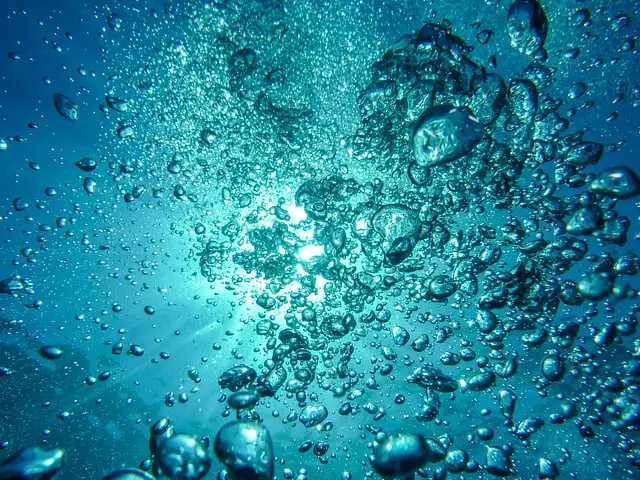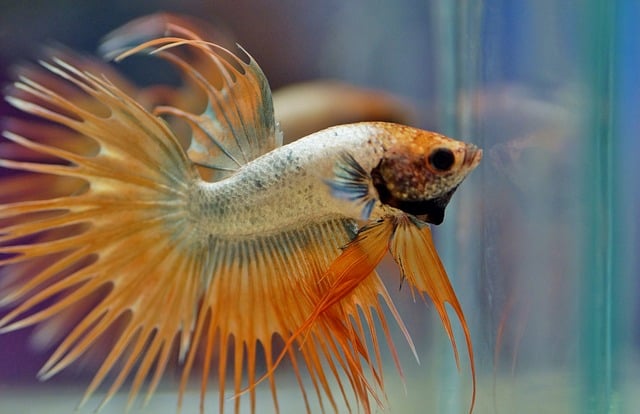There is nothing more enjoyable than watching a crystal-clear aquarium with the fish swimming around it, having fun. Then, out of the blue the water, goes green and spoils your viewing pleasure. What happened? Let me tell you this happens quite often, especially to newer aquarium hobbyists and sometimes to the veterans as well. So, what gives?
Aquarium water turns green because of water borne algae blooms. The main reasons are poor fish tank maintenance, over feeding, aquarium exposed to direct sunlight, algae bloom brought in from another tank and increased nitrates and phosphates.
Of course, most of the causes of green fish tank water are all related, aside from direct sunlight. In this article, I will go over each of these points and identify how the green algae blooms start and what you can do to remedy the issue. Mostly, what it all boils down to is proper care and maintenance. So, if you’re ready to learn more, then let’s get started.
Poor Fish Tank Maintenance
Poor fish tank maintenance is the most common reason a fish tank gets water borne green algae. With proper and regular tank maintenance you can overcome your green water issue and start enjoying a beautiful clear water tank again. One thing you’ll notice when you have a clean tank, it doesn’t stink like a dirty one. That’s another reason to do regular maintenance.
What is Poor Fish Tank Maintenance?
Poor maintenance means neglecting your aquarium. Not vacuuming the substrate, not performing water changes, not cleaning filter medium, not cleaning the inside glass/acrylic, not clearing out dead fish and so on.
How Does Poor Maintenance Cause Green Fish Tank Water?
The problem with poor tank maintenance:
When you don’t vacuum your substrate to rid your tank of old water, decaying waste, excess food, dead plants and fish your nitrates and phosphate levels rise and the likelihood of green water algae blooms starting becomes very likely.
- But there is more. Proper maintenance on your filter is required as the problems we just mentioned with decaying plants and excess food and waste can accumulate in your filter without you realizing what is going on. Again, your chance of having green water from this rises if proper maintenance is not performed.
How to Fix Poor Aquarium Maintenance
A water change is one of the most important maintenance tasks you can perform.
I said it already and I will say it again, vacuum your substrate on a regular basis. If you have a gravel substrate you must make sure to push the end of the vacuum down into the gravel to get all the goodies out of there.
I do mine almost every weekend. For sure every two weeks. If I do a vacuum/water change most weekends and when I do every week, I take out about 25% of the water before I stop. When I miss a weekend, I vacuum out almost 50% of the tank’s water. This is for freshwater tanks.
You should shoot for close to the same percentages. Find what works for you and your scedule, this is just something to shoot for until you gain more experience in tank maintenance.
- Make sure you pick out any floating pieces of dead plant or other debris as it all makes a difference in the health of the tank’s water.
- Your filter medium needs to be replaced and or cleaned on a regular basis as well, but probably not as much as you think. Once you have a clear tank, you don’t have to look at your filter every week. Here’s what I do.
- Every week I take a visual on how the water is flowing out of the filter and if it looks strong and there are no obvious issues with the water, I leave it alone. Every 2 to 3 weeks I rinse out the sponge in tank water that I had vacuumed out. If I have charcoal in the filter, I take a visual of the charcoal bag and if it looks like it has a lot of green and other guck on it, I change it out. I usually do this, every 6 weeks, or so.
- Don’t let the packaging on your aquarium filter medium, steer you wrong. These companies are in the business to sell these products so of course they will say change everything out at a minimum of once a month. You don’t need to though, unless you have an issue with your tank’s water that you are trying to remedy.
- Lastly, stop feeding your fish so much food. I know I know, it’s so hard, to not treat your fish to extra food. Fact is though, you are probably feeding your fish too much food even when you’re not treating them. When you are feeding flakes to your fish, a lot of them end up in your substrate no matter how much you give them. That little bit of overfeeding every day adds up to big problems.
- I recommend cutting back slightly every feeding until you rarely see any food hit the bottom of the tank. Even when your water isn’t green anymore, but crystal clear. That’s, how you keep your tank’s water, so clear.
Water changes are an effective method of taking nitrates out of your tank. A water change alone will not help very much to lower your phosphates. The way that happens is when you vacuum out all the decaying matter, then the phosphate levels will lower. It’s the debris that needs to be removed to fix the phosphates. This is another reason why it’s important to clean your filter as well.
Direct Sunlight and Overly Bright Lights Can Cause Algae
If your tank is sitting in direct sunlight, this could be the cause of your green water algae bloom. Now, there must be the right conditions existing already in your tank for this to happen such as high levels of nitrates and phosphates.
The way this works is the sun causes any microscopic molecules of algae to grow rapidly, just like the sun does when it comes to photosynthesis for plants.
Having very bright aquarium lights can have the same affect on your water.
The fix:
Move the tank to a location away from direct sunlight. Or, make sure you have the blinds or curtains closed during the daytime. Pretty simple.
- If overly bright aquarium lights are the problem, then cut back to how long they are on for. Rule of thumb has always been to have lights on for no longer than there is typically daylight, so about 12 hours a day. I used to do that but have cut back to nine hours a day. I have timers that turn on at 12 noon and turn off at 9PM every day.
- I don’t have very much algae however, I am still considering cutting back another hour or so. The thing is most tropical and marine fish don’t mind having the lights off. They feel safer and less stressed when there isn’t a glaring light shining down on them. I say that like I know what they are thinking and of course, I don’t, it’s the way they move around the tank even when the lights are off that I know they are happy.
Water From Another Tank Being Added Can Cause an Algae Bloom
We trust our local fish stores so much that a large majority of aquarium hobbyists purchase fish, bring them home and put them in their tanks immediately. This isn’t always a good idea because fish stores can have algae problems and all sorts of water issues you could be bringing home. I have been burnt this way in the past.
You purchase a new fish or two, bring them home and place them in your tank to start enjoying. Then within a week you have an algae problem whether it’s a green water algae or other type of algae. It happens. The way to remedy this is to have a quarantine tank. I have an article on the topic which can be found here.
I have not only brought home algae, I have had issues with scuds and snails when purchasing live plants for freshwater tanks. I now quarantine plants as well. Do yourself a HUGE favor and set up a quarantine tank. I usually quarantine for no more than two weeks. Usually after five to seven days you will see if there are any issues with the fish or plants in quarantine.
What’s the Best Way to Get Rid of Green Tank Water Now?
So, after all of this, what if you have a green water algae problem right now, what can you do to start the process of clearing it up?
Start by performing proper tank maintenance and doing a water change of over 50% Then do another one in four or five days.
Get your tank out of direct sunlight and don’t have the lights on as much.
There are also chemicals you can purchase that will help clarify the water however, I prefer not to use them. That’s your choice, though. You should know that the green water problem you have is not really harming your fish as much as it is an eyesore for you looking at the tank. Consider that before you add chemicals to the tank.
Fish tank chemicals can also harm the beneficial bacteria which is a quick way to kill all your fish. I am not trying to scare you. I just want to give you all the information you need to make the best decisions for you and your fish.
There are pieces of aquarium equipment you can use to help you fix your green water problem quickly. They are UV filters (also called sterilizers) and Diatomic filters.
There are different types of UV filters you can purchase such as internal UV filters that get placed inside your tank like a power head. Or, you can purchase an inline UV filter that works with a canister filter system. It would be installed in the inlet line feeding the canister filter.
UV filters will zap the water borne algae as it passes through the filter killing any algae spores. For a beginner, I would recommend trying an internal UV sterilizer as it would be more cost effective than an inline style. I can recommend this UV filter on amazon as one that works great.
For more information on UV sterilizers for aquariums, please go check out my article on the subject HERE.
A diatomic filter is a nice piece of aquarium filter to have as they clean your water right down to the microbe level. They are a bit expensive, but they have an excellent reputation of cleaning just about anything tiny out of fish tank water. They work so well the term used for diatom filters is polishing the water.
If you want a recommendation for a diatom filter, check this one out over on Amazon.
Last Words
When your fish tank turns green, it’s a problem, plain and simple. The faster you move to fix the problem, the easier it will be to do so. If you take your time, you will have a terrible time cleaning the green up.
Luckily, it’s not really dangerous for your fish, but that shouldn’t give you an excuse to drag your feet cleaning up the tank.
I really do recommend a UV sterilizer filter for your tank. They work wonders. If you get one, make sure to get one that can handle tanks even bigger than yours. That way you will know it is big enough for your tank. These filters are super easy to use and will clean up more than green water algae.
Good luck with cleaning up your fish tank!
Related Aquariums at Home Articles
Why is my Fish Tank Water Yellow?
HOB VS Canister Filter, Which, is Best for You?
Are Saltwater and Freshwater Filters the Same?
Why Your Fish Tank Stinks and How to Fix it






